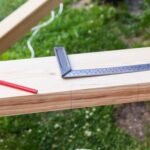What is a jointer used for in woodworking? Woodworking is a skilled craft that requires an understanding of various tools and techniques to create finely crafted pieces. One important tool in the woodworker’s arsenal is the jointer, which plays a crucial role in achieving precision and accuracy in woodworking projects.
A jointer is a woodworking tool designed to flatten and straighten the edges of boards and create flat surfaces on wood. It consists of a flat surface, known as the tables, and a cutting head with rotating knives that removes material from the wood as it passes over the tables. This process results in smooth, straight edges and flat surfaces crucial for joining pieces together seamlessly.
Understanding the function and importance of a jointer is essential for any woodworking enthusiast or professional. In this article, we will delve into the intricacies of this versatile tool, including its different types, techniques for use, safety precautions, maintenance, and much more. By gaining knowledge about jointers and their role in woodworking, individuals can expand their skills and produce high-quality wood creations with precision and finesse.
What Is a Jointer
A jointer, also known as a surface planer, is a woodworking tool designed to create a flat surface along the length of a board. It consists of an infeed table, an outfeed table, a cutter head, and a fence.
The infeed table is adjustable and allows the user to remove material from the board gradually, while the outfeed table supports the board as it moves through the cutter head. The cutter head contains rotating blades that shave off thin layers of wood to smoothen the surface.
The primary function of a jointer is to ensure that one face and one edge of a board are perfectly flat and at right angles to each other. This process is crucial for creating straight, uniform edges for joining multiple boards together, such as in cabinet-making or furniture construction. Additionally, a jointer can be used to correct any warping or bowing in wood, making it an essential tool for achieving precision and accuracy in woodworking projects.
Types of Jointers:
- Benchtop Jointer: These are compact and portable jointers suitable for small-scale woodworking projects.
- Closed Stand Jointer: These jointers have an enclosed base that provides additional support and stability during operation.
- Long-Bed Jointer: Designed for larger boards and heavier usage, long-bed jointers offer extended cutting capacity for extensive woodworking tasks.
Overall, understanding what is a jointer used for in woodworking can greatly enhance the quality and craftsmanship of woodworking projects by ensuring that boards are properly flattened and squared before further processing. By learning about the different types of jointers available and their specific uses, woodworkers can make informed decisions when selecting the most suitable tool for their individual needs.
Types of Jointers
A jointer is a woodworking tool used to create a flat surface along the edge of a board, allowing for a seamless and tight fit when joining multiple pieces together. There are several types of jointers available in the market, each with its own unique features and specific uses.
One common type of jointer is the benchtop jointer, which is compact and ideal for small to medium-sized woodworking projects. This type of jointer is easily portable and can be placed on top of a workbench, making it convenient for hobbyists and DIY enthusiasts.
Another type is the long-bed jointer, which has an extended cutting surface, making it suitable for handling longer and wider boards. Professional woodworkers often opt for this type of jointer due to its capacity to accommodate larger pieces of wood.
Additionally, there are also spiral cutterhead jointers that utilize helical cutterheads instead of traditional straight blades. These spiral cutterhead jointers offer advantages such as reduced noise, smoother finishes, and decreased tear-out when working with highly figured or challenging grain patterns in wood. Woodworkers can choose from various options based on their specific needs and the scale of their woodworking projects.
In summary, understanding the different types of jointers available in the market is essential for woodworkers looking to achieve precision and accuracy in their projects. Whether it’s a benchtop jointer for smaller tasks or a long-bed jointer for larger-scale endeavors, selecting the right type based on specific requirements can significantly impact the quality of woodworking outcomes.
| Type of Jointer | Specific Uses |
|---|---|
| Benchtop Jointer | Ideal for small to medium-sized woodworking projects; easily portable |
| Long-Bed Jointer | Suitable for handling longer and wider boards; preferred by professional woodworkers |
| Spiral Cutterhead Jointer | Utilizes helical cutterheads; offers reduced noise and smoother finishes |
Jointing Techniques
When using a jointer in woodworking, it is essential to understand the various techniques and methods that can be employed to achieve the desired results. Whether you are looking to create a smooth, flat surface on a piece of wood or produce perfectly aligned edges for joining, utilizing the right jointing techniques is crucial for successful woodworking projects. Here are some common jointing techniques used with a jointer:
- Edge Jointing: This technique involves running the edge of a board along the jointer’s fence to create a straight and smooth edge. By removing any irregularities or roughness from the edge, edge jointing ensures that multiple boards can be joined together seamlessly.
- Face Jointing: Face jointing is used to flatten one face of a board by running it over the cutter head of the jointer. This process helps to eliminate any warping or cupping in the wood, resulting in a flat and even surface.
- Rabbeting: A rabbet is an L-shaped notch created at the end or along the edge of a board. The jointer can be used to produce rabbets by adjusting the depth and position of the cutting blades.
By mastering these jointing techniques, woodworkers can enhance their craftsmanship and achieve professional-looking results in their projects.
By incorporating these techniques into your woodworking endeavors, you can maximize the capabilities of your jointer and elevate the quality of your work. Remember that practicing proper safety precautions and wearing appropriate protective gear when using a jointer is imperative to avoid accidents or injuries. Understanding these different techniques will not only improve your woodworking skills but also enable you to fully utilize what is a jointer used for in woodworking – precision and accuracy in shaping and surfacing wood.
Importance of Using a Jointer
A jointer is an essential tool in woodworking that plays a crucial role in achieving precision and accuracy in projects. Whether you are working on creating smooth edges, flattening surfaces, or creating perfect joints, a jointer is a must-have in any woodworking workshop. Understanding the importance of using a jointer can greatly improve the quality of your finished products and enhance your overall woodworking experience.
Benefits of Using a Jointer
One of the main benefits of using a jointer in woodworking is its ability to create flat surfaces on rough lumber. This is achieved by running the surface of the wood through the jointer’s cutter head, which effectively removes any imperfections or unevenness.
The result is a perfectly flat and smooth surface that is ready for further processing and joinery work. Additionally, a jointer can be used to create straight edges on boards, making it easier to achieve seamless glue-ups for panels and other woodworking projects.
Precision in Woodworking
When it comes to precision in woodworking, a jointer plays a vital role in ensuring that all pieces of wood fit together seamlessly. Whether you are creating intricate joinery or simply aligning edges for a clean finish, the use of a jointer can greatly enhance the accuracy of your work. By producing square and straight edges, as well as flat surfaces, the jointer contributes to the overall precision of your woodworking projects.
Achieving Professional Results
Incorporating a jointer into your woodworking process allows you to achieve professional-level results with ease. The ability to precisely shape and prepare wood for further construction not only enhances the aesthetic appeal of your final pieces but also adds structural integrity. With its contribution to accuracy and precision, a jointer elevates your woodworking capabilities and empowers you to tackle more advanced projects with confidence.
Safety Precautions
When using a jointer in woodworking, it is essential to prioritize safety to prevent accidents and injuries. A jointer is a powerful tool that can effectively flatten and create straight edges on wood, but it also poses potential risks if not used correctly. Therefore, it is crucial to follow specific safety precautions to ensure a safe working environment when operating a jointer.
One of the most important safety measures when using a jointer is wearing personal protective equipment (PPE). This includes safety goggles or glasses to protect the eyes from flying wood chips and dust, ear protection to minimize noise exposure, and gloves to provide better grip and protect the hands from rough wood surfaces. Additionally, it is advisable to wear fitted clothing and tie back long hair to avoid entanglement with the rotating cutter head of the jointer.
It is also vital to keep the work area clean and organized when using a jointer. Cluttered or messy workspaces can increase the risk of accidents, so maintaining a tidy environment can help prevent tripping hazards or accidental contact with sharp tools.
Furthermore, always ensure that the jointer is placed on a stable surface and that all its components are securely in place before operation. Following these safety measures will greatly reduce the likelihood of accidents while using a jointer in woodworking projects.
| Safety Measure | Description |
|---|---|
| Wearing Personal Protective Equipment (PPE) | Includes safety goggles, ear protection, gloves, fitted clothing, and tied back hair |
| Maintaining Clean Work Area | Prevents tripping hazards and accidental contact with sharp tools |
| Ensuring Stability of Jointer | Placing the machine on a stable surface and securing all components before operation |
Tips for Using a Jointer
After understanding what a jointer is and its importance in woodworking, it’s crucial to learn how to use this tool effectively and efficiently. In this section, we will discuss several practical tips and advice for using a jointer in woodworking projects.
Understanding the Workspace
Before using a jointer, it’s essential to ensure that your workspace is clean, organized, and free from any obstructions. This includes debris, sawdust, or any other materials that could interfere with the operation of the jointer. Additionally, make sure there is adequate lighting in the workspace to clearly see the woodworking material and maintain precision during the jointing process.
Selecting the Right Jointer
When working on a woodworking project, it’s important to select the right type of jointer for the task at hand. Depending on the size and nature of your project, you may need to choose between a benchtop jointer, an open stand jointer, or a closed stand jointer. Consider the width and thickness capacity of each jointer type, as well as your specific project requirements before making a selection.
Proper Technique
Using proper technique is crucial for achieving accurate and precise results when using a jointer. Always feed the wood against the rotation of the cutter head and keep consistent pressure throughout the process. It’s also important to maintain a steady pace while feeding the material through the jointer to avoid uneven cuts or sniping.
By following these practical tips and advice for using a jointer effectively in woodworking projects, you can achieve professional-quality results while ensuring safety and precision throughout the process.
Jointer Maintenance
In conclusion, understanding the role and function of a jointer in woodworking is essential for any woodworker, whether they are a beginner or an experienced professional. A jointer is a crucial tool that helps in achieving precise and accurate results in woodworking projects. By using a jointer, woodworkers can create flat surfaces, straight edges, and perfectly aligned boards, which are vital for creating high-quality furniture and other wooden items.
Furthermore, knowing the different types of jointers available in the market and their specific uses allows woodworkers to choose the right tool for their projects. Additionally, mastering various jointing techniques and following safety precautions while using a jointer are equally important to ensure efficient and safe woodworking practices.
Proper maintenance of a jointer is also key to its longevity and optimal performance. Regular cleaning, lubrication of moving parts, and inspection for any signs of wear or damage are all essential aspects of jointer maintenance. By taking care of this valuable tool, woodworkers can continue to produce outstanding woodworking results for many years to come. Overall, understanding what a jointer is used for in woodworking and how to utilize it effectively is fundamental to achieving success in woodworking projects.
Frequently Asked Questions
Why Do I Need a Jointer if I Have a Planer?
You need a jointer even if you have a planer because they serve different purposes in woodworking. While a planer is used to create boards with consistent thickness, a jointer is used to create flat and smooth faces on the board. The jointer also helps in squaring up board edges, which is important for creating strong and seamless joints.
When Should You Use a Jointer?
A jointer should be used when you need to flatten one face of a warped or rough-sawn board and square up its edges. This is especially important when working on projects that require precise and seamless joints, such as creating tabletops, cabinets, or frames.
Using a jointer ensures that the boards are straight, flat, and perfectly squared before further processing with other tools like the planer.
What Is Difference Between Jointer and Planer?
The main difference between a jointer and a planer lies in their functions. A jointer is designed to flatten one face of a board and square up its edges, while a planer is meant for making the opposite face parallel to the first flattened face – essentially making the board’s thickness uniform throughout its length.
In essence, the jointer prepares the wood for planning by creating one flat reference surface while the planer then makes both sides parallel and uniform in thickness.

Hi everyone! I’m a woodworker and blogger, and this is my woodworking blog. In my blog, I share tips and tricks for woodworkers of all skill levels, as well as project ideas that you can try yourself.





